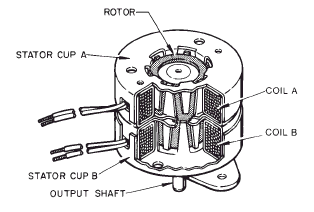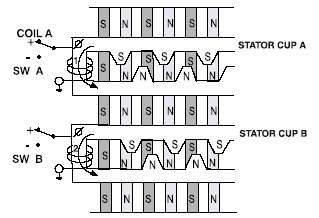Stepper Motor Application and Operation
Industrial Electric Motors and Generators Menu
Stepper Motor Application and Operation
Stepper Motors convert electrical pulses into discrete mechanical rotational movement or steps. Typical stepper motors consists of two coils with two stator cups formed around each coil. Pole pairs are mechanically displaced by one-half each pole pair. When current is applied, the pole pairs become alternatively energized north and south poles. Between the stator coil pairs, there is a displacement of one quarter of each pole pitch.


Step/Motor stator polarity/ rotor position.
Stepper motor operating performance specifications may be as follows: Holding torque, step angle (Degrees), steps/rev, DC operating voltage, resistance/windings (ohms) for a given applied voltage. Length, diameter, shaft size, and interface are other mechanical specifications available from the manufacturer.
Typical stepper motors are used in any application which requires a discrete rotational movement. Examples; an indexing table or conveyor, optical scanner (3D laser scanner), photo or film processing machine, BBQ grill (we don't want that chicken to burn), etc. Stepper motors are also used with accompanying mechanisms (gears) to translate the rotational movement into linear displacement applications.